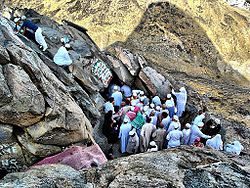Jabal al-Nour
Holy mountain and peak in Saudi Arabia From Wikipedia, the free encyclopedia
Jabal al-Nour (Arabic: جَبَل ٱلنُّوْر, romanized: Jabal an-Nūr, lit. 'Mountain of the Light' or 'Hill of the Illumination') is a mountain near Mecca in the Hejaz region of Saudi Arabia.[1] The mountain houses the grotto or cave of Hira (Arabic: غَار حِرَاء, romanized: Ghar-i-Hira, lit. 'Cave of Hira'), which holds tremendous significance for Muslims throughout the world, as it is here where the Islamic prophet Muhammad received his first revelation of the Quran, which consisted of the first five ayat of Surah Al-Alaq from the angel Jibra'il (as is pronounced in certain Quran recitation schools and some Arab tribes; also known as Gabriel).[2] It is one of the most popular tourist attractions in Makkah. The mountain itself is barely 640 m (2,100 ft) tall; nonetheless one to two hours are needed to make the strenuous hike to the cave. There are 1750 steps to the top which can take anywhere between half an hour and three hours.[3]
| Jabal al-Nour | |
|---|---|
 Jabal al-Nour in the vicinity of Mecca | |
| Highest point | |
| Elevation | 642 m (2,106 ft) |
| Coordinates | 21°27′29″N 39°51′41″E |
| Naming | |
| Native name | جَبَل ٱلنُّوْر (Arabic) |
| Geography | |
| Location | Makkah Province, Hejaz, Saudi Arabia |
| Parent range | Hijaz Mountains |
Etymology
This is where Muhammad is said to have had his first revelation and received five verses of the Quran, the mountain was given the title Jabal an-Nūr ("Mountain of the Light" or "Mountain of the Enlightenment"). This experience is sometimes identified with the beginning of revelation; hence the present name.[4] The date of the first revelation is said to have occurred on Laylat al-Qadr,[5] one of the last 10 nights of Ramadan, suggested to have been around August of 610 A.D.
Appearance
One physical feature that differentiates Jabal al-Nour from other mountains and hills is its unusual summit, which makes it look as if two mountains are on top of each other. The top of this mountain in the mountainous desert is one of the loneliest of places. However, the cave within, which faces the direction of the Kaaba, is even more isolated. While standing in the courtyard back then, people could only look over the surrounding rocks. Nowadays, people can see the surrounding rocks as well as buildings that are hundreds of meters below and hundreds of meters to many kilometers away. Hira is both without water or vegetation other than a few thorns. Hira is higher than Thabīr (ثَبِيْر),[a] and is crowned by a steep and slippery peak, which Muhammad with some companions once climbed.[8]
Geology
The mountain is composed of intrusive igneous rocks, predominantly Precambrian aged coarse grained hornblende tonalite, with subordinate granodiorite.[9]
Cave of Hira
Summarize
Perspective

The Cave of Hira was of minor significance before Islam, its name comes from hira (jewels). Taking 1750 walking steps to reach, it is about 3.7 m (12 ft) in length and 1.60 m (5 ft 3 in) in width.[2] It is at a height of 270 m (890 ft).[10] During the Hajj (pilgrimage), an estimated five thousand visitors climb to it daily to see the place where Prophet Muhammad is believed to have received the first revelation of the Quran on the Laylat al-Qadr (night of power) by the angel Jibreel (Gabriel).[10] Most Muslims do not consider visiting the cave an integral part of the Hajj. Nonetheless many visit it for reasons of personal pleasure and spirituality, and though some consider it a place of worship, this view conflicts with Salafist interpretations of Islamic ritual. While the cave plays an important role in As-Sīrah an-Nabawiyyah (prophetic biography), it is not considered as holy as other sites in Mecca, such as the Al-Haram Mosque, and so under most interpretations of Islam, the same reward is received for praying here as any other place in Mecca.[11]
Before Prophet Muhammad's first revelation, he had transcendental dreams, in which were signs that his prophethood had begun and that the stones in Mecca would greet him with the salaam. These dreams lasted for six months.[12]
An increasing need for solitude led Prophet Muhammad to seek seclusion and meditation (Muraqabah) in the rocky hills which surrounded Mecca.[13] He retreated to the cave for one month each year, engaging in seclusion (Tahannuth).[b][4][16] He took provisions and fed the poor who came to him. Before returning home to his family for more provisions, he would circumambulate the Kaaba seven times.[16]
Gallery
- View of Jabal al-Nour
- People entering the Cave of Hira
- Overview of Jabal an-Nour
- Cave Hira
- Jabal e Noor
- A photograph of Mecca in 2019, featuring Al-Masjid Al-Haram in the foreground, and Jabal an-Nour in the background. Jabal Abu Qubays is to east of the mosque, in the right hand side of the photograph.
See also
References
External links
Wikiwand - on
Seamless Wikipedia browsing. On steroids.







